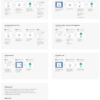Passenger Transportation Modernization Project
Simplifying the management of data in a complex network of systems
Client: B.C. Ministry of Transportation and Infrastructure
Project duration: 3 years (ongoing)
Tools: Balsamiq, Azure, Adobe Creative Cloud
UX techniques used: Journey Map, Process Flow diagram, User Interviews, Wireframes, High-Fidelity Mockups, User testing
My Role
I was the only UX designer in my team. The task involved working closely with the three business analysts and the stakeholders of each branch to understand their complex systems and how they intermingle.
Primary Business Goals
- Having a system for each branch
- Enabling the employees to seamlessly access the relevant information from all branches within their system.
- Make sure that the information is accessed in a shared database and configured so that everyone can access and understand.
Our Process
User Research
We interviewed some employees in each branch to get information on how they were using the systems and the experiences they had. We then took time to watch them doing their day-to-day tasks. We then met with the branch managers to understand why the systems were designed the way they were, what had been working well for them, the friction points they experienced, and where they were wasting time or doing extra work to accomplish a task. I then created personas to represent all the users, mapped user journeys based on the interviews, and analyzed the current user flows to find ways to improve the processes.
We figured out the biggest gap was to record and keep track of more than the current system allows and access that information easily.
The Concept of “Interaction”
We needed to get a clear picture of how things were and imagine how they could be. After months of research and documentation, we thought we had a solution and many whiteboard and brainstorms sessions.
Each branch has many points of contact with the public requiring services from the Ministry. Some of the services that the clients need from the Ministry include applying for a carrier certificate, paying a fee to renew a permit, applying to become an authorized inspector, changing the business address or management, getting a vehicle inspected at a designated facility, or perform an audit. We documented well over 30 different types of interactions that could happen between the Ministry, the people reporting to them, and the general public. All the interactions were recorded, but there was no consistency from one system to another. We needed to make the system accessible and reduce the time and effort to retrieve the information. The main solution that was applied to solve the problem was to record the information appropriately in a standard form and make it available to anyone that needs it.
Developing the Concept of Interactions in the New System
Paper Sketching and Planning
I sketched the interaction patterns that could be followed to make service delivery much easier using user research and my creativity. My suggestion was to make each point of contact available in interactions to improve service delivery significantly. Each Interaction would be created when some actions were performed by ministry employees or automatically created and documented. Each Interaction would be associated with one of the 20,000 carriers with an NSC certificate. The most important thing is that everything would be interconnected and easily searchable on a dedicated search screen. Users can use one or many criteria to search for an Interaction.
For example, a user could search for every carrier within a specific area that had an inspection done during a specific period or view the Carrier Profile Interaction History. All the Interactions for that carrier would show in chronological order. Clicking an Interaction Number in the Interaction history would show all the specific details.


All Interactions are assigned a significant number: year, three letters code for the branch (NSC, VIP), two letters code for the Interaction (AU for Audit, WL for Warning Letter), and five digits number, starting at 00001 for the first Interaction recorded in the year and increasing by 1 for each other Interaction created. So the first Interaction of 2023, an NSC Audit, would have the number 2023NSCAU00001.
Wire-framing and Prototyping
I prepared some wireframes, documented the new processes to create the interactions, and Chris and I presented the idea to all the Branch Managers. After answering many questions and addressing concerns, the idea was accepted by all branches with enthusiasm.
Conclusion
We had to document and train all the Ministry employees (users) to use this new feature as we started rounds of testing. This was a big change from what they used to, but we had full support from all the Managers who understood its value. After a short learning curve, all users were raving about how much this idea would make their work easier and faster.
This huge project has been underway for three years. We managed to simplify the flow of information, so everything is recorded in one central place, easily searchable, and much more user-friendly.




